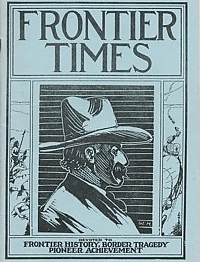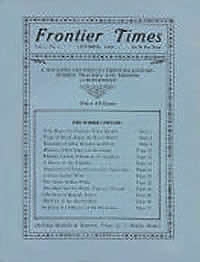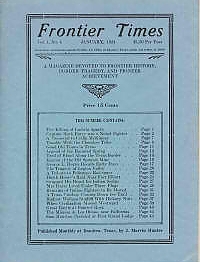By using our website, you agree to the use of cookies as described in our Cookie Policy
Magazines & Instant Downloads
Vol 11 No. 11 - August 1934
Fort Davis Opened Trail Through Bad Lands of Texas
San Antonio Express. This is an excellent, detailed and fairly lengthy account of the establishment of Fort Davis, and the strategic role it played in opening up a vast section of frontier for trade and settlement. An excerpt: "In the Big Bend of the Rio, which gives its name to the enclosed area, more than half of which is mountains, there are 181 peaks over 4,000 feet high, 35 elevations over 6,000 feet, and three which exceed 8,000 feet. El Capitan, 9,020 feet, on the. road from Van Horn. to Carlsbad Caverns, is the highest, peak in the United States outside the, Rockies. The natives of this rough section were the Mescalero Huapaches and Gila Huapaches, who held these mountains for their own. Presently the Southern Comanches were pressed across the Pecos, their time-respected boundary, by the. oncoming white man, who was now advancing his homesteads across the Staked Plains. It was a bitter pass, for both tribes. In '49 the vanguard of the "gold rush" crossed the Pecos, and ventured into these supposedly impregnable fastnesses. The news was signaled across the mountains and incited the tribes to a fierce, no-quarter war which continued for thirty years. For ten years after reservations were set up these enraged Indians raided the trails and Settlements with cunning and barbarism which at times held the white man at a standstill. From the day that the troops made camp at La Limpia, which was to become a post, Fort Davis was the real objective in every advance, and the Mescaleros were determined to destroy it. Colonel Seawall made himself secure in adobe quarters, and then began his systematic campaign to push the Apaches back into fewer and fewer retreats. He threw out his force in patrols along the two trails, making contact with wagon trains, emigrant companies and the mail service at strategic points. Fearless attacks and resourceful defense kept the Indians at a disadvantage, and swift reprisals for their outbreaks…"
Further Mentions: Cabeza de Vaca, Limpia Canyon, the Old Salt Trail from Chihuahua City north, on Oct. 7, 1854, Liutenant Colonel Washington Seawall appeared on Limpia Creek with his force of 400 men of the Eighth Infantry, and they had to fight their way down the canyon through an Indian ambush, with warriors behind every boulder., El Muerto, or Deadman's hole, Lieut. Randall, Canyon de los Lamentos, now called Quitman Canyon, Dedrick Dutchover, Capt. Pawker Col. Baylor, Senor Manuel Musquiz, Lieut. Mayes, the 9th Cavalry, Lieut. Col. Wesley Merritt commanding, Sam Miller, Sawmill Canyon. Victorio, a noted Apache raider, Tarahumar Indian, Nicholas Mersfelder who came to Fort Davis in 1881 and lived near the fort enclosure, Nicholas Mersfelder's, Ranger Camp on Mitre Peak,
Indian Stronghold Is Now Peaceful Texas Town
By S, Kirgan, in Houston Chronicle. ONE OF the most picturesque and interesting, little towns in Texas is Tehuacana. Located on a rise of hills, it commands an incomparable panoramic view of many miles of blue distance. This quaint little community, 50 miles east of Waco, was the scene of one of the most violent clashes of the early days, a battle between the Cherokees and the Tehuacanas, from which only 12 of the Tehuacanas escaped. On the top of the highest, hill, overlooking the town, is Westminster College. Founded in 1869, it is one of the oldest institutions in Texas. There, on that ridge, the great battle of The Cherokees and the Tebuacanas bad been fought. This account told by Rev. J. W. Pearson, who was born in Coosa county, Alabama, September 8, 1852, and moved to Texas in December, 1869, settling near Bryan, in Brazos county. He moved to Austin in 1874, and then to Limestone county in 1879, and entered Trinity University in September of that year as a student for the ministry of the Cumberland Presbyterian denomination. He was graduated in 1884, and was married to Miss Kate, George in 1886. He spent over 55 years in Tehuacana.
Further Mentions: Major John Boyd, Battle Creek fight, Dawson, in Navarro county, the town of Franklin, in Robertson county, Capt. William M. Love. Tolmacana Hills,
Early Settlers on the Colorado in McCulloch County
By Clarence Snider, Brady, Texas. NOTE: THOUGH MANY ARE LOVE THESE FRONTIER TIMES MAGAZINES BECAUSE THEY LOVE TEXAS AND LOVE FIRST-HAND ACCOUNTS OF RICH TEXAS HISTORY, THIS ARTICLE SHOWS WHY THESE VOLUMES ARE SO VALUABLE TO GENEALOGICAL RESEARCH. AN EXCERPT:
"THE EARLIEST settler in this section is believed to have been Jonothan Mulkey, who came front Austin with his three sons, Jim, Lewis and W. R. (Bill). Jim Mulkey, who was one-quarteir Cherokee Indian, acted as guide for the soldiers and others dealing with the Indians. Lewis Mulkey was a member of Captain W. G. O'Brien's Company of Rangers stationed at Camp San Saba during the early part of the war; W. R. Mulkey was a member of Lieutenant Dick Barton's Company of "Minute Men" in 1864. The Mulkeys first settled on Deep Creek, near where Milburn is now located. Shortly afterwards, Bill Mulkey built a house on the Colorado river a short distance above the old No. 10 Highway bridge.
The Jim Alulkey mentioned above is not to be confused with another Jim Mulkey, who was a son of V. R. Mulkey and son-in-law of Lish Wilson, and is remembered by a good many people of the present time.
About the same time M. L. Hull with his two sons, Cagie and Elbert came; they lived on what has been known as the Beasley place for sixty years or more. Jim Phillips, Jim Richardson, Steve Wiley and Tom Bynum, sons-in-law of Hull, were here at an early day. In I858, Warren F. Hudson-still living near Hall, Texas-came and lived with the Mulkeys. Early in the spring of 1862, Elisha (Lish) Wilson and his brother, A. W. (Wayne) Wilson, came into this section looking for cattle range and decided to locate. Lish Wilson hired the two Hull boys to build him a log house while they went back to Palo Pinto county after their families and livestock. This house was occupied by both families for a time, and was built of logs with a puncheon floor and stood close to the river batik on what is now known as the Lindley farm, owned by Sid Cox, It was later burned by the Indians. In the fall of 1862, J. T. Keese, afterwards known as Judge Keese, and for whom the Keese Crossing is named, came. He married Mrs. Lindy Parker, mother of John, Jim, George and Bill Parker and three girls. The same year, J. W. Cox came (not to be confused with AT. E. Cox, a prominent citizen who came in 1874) and John Beasley, better known as Judge Beasley, with his two sons, Newt and Bill. John Beasley was elected or appointed the first County Judge of McCulloch county in 1866, and, served the county in that and other capacities for many years. The neighborhood where he lived is referred to on the, early county records as the Beasley neighborhood, and the section of the river where he lived was called the Beasley Bend. He was father of the late John R. Beasley of Mercury, Texas. J. N. (Newt) was a member of the Minute Men during the Civil War, and about 1880 had a grist and saw mill on Deep Creek. Judge John Beasley's sons-in-law, A. S. Harvick and F. M. Hodges, also lived here during the Civil War. As near as can be figured, Shelby Wilson, brother of Lish and Wayne, came in 1863. The State records show that he served as county commissioner of McCulloch county for the years 1864, 1865 and 1866. He was married to Mrs. Singleton, who had two boys, Jeff and. Wash, and two girls Mrs. John Parker and Mrs. Lish Wilson. There were six Wilson children: Dick and Lein, and four girls, At all early day lie built a nice two-room rock house. This house has recently been rebuilt and is now occupied. Wayne Wilson also built a rock house at the same time. Shell Wilson died about 1880. All three of the Wilson brothers were members of Lieutenant Barton's Company of Minute Men in 1864…"
Further Mentions: Mrs. Sarah Jane Wilson, mother of the three Wilson brothers mentioned above, died about 1865, and was the first person buried in what is known as the Cox cemetery. Rev. Chris, a minister of the Christian church, J. C. Chamberlain, David McAllister, Dr. Jonothan Lindley, grandfather of Dr. H. W. Lindley of Brady, four sons: Simon, Jake, Newt and Jasper. Another early settler was a man named Nichols, who settled on Deep Creek, and cleared up a small valley farm on Rough Branch. J. A. Bush and Miss K. Parker, the home of John Parker, that the first killing in this section is said to have occurred, Wayne Wright, Dick Hudson, John W. Jump, Mr. Jump was tax assessor of McCulloch county in 1866, Lieutenant Dick Barton, John R. Johnson, Pete Edmon, "The Dugout," the Ollie Pointer residence, A man named Brown is thought by some to have had the first store, but David McAllister had a store at a very early date. His store was burned by the Indians at the same time the Lindley residence was burned, namely, May 13, 1869. Some others who had stores at various times were Estes, C. W. Taylor, A. D. Greathouse, Preacher Stearman, Uncle Jack Trowell, Henry Chamberlain and Jim Gober had a saloon, John and Jim Vaughn, A man named Alverson bad a blacksmith shop and was postmaster at one time. Charley Wilson was also a blacksmith. Doctor Garner was the first physician, Fred Fetter and his wife, M. E. Fetter. Sam Allison and Joe F. Brown, the Randol place. Professor Souther schools were taught by Rev. A. B. Roberts, Rev. Brown, father of Charlie Brown of Richland Springs, Miss Minnie Cravens and W. H. Winebrenner, Joe Long, Revs. Lee and Brown, Baptist, Rev. R. T. Short and Rev. A. B. Roberts, Methodists, Rev. Geo. Lane, Dr. McClellan, W. C. Weir, Bill Humphrey. Etc, etc. IF YOU HAVE FAMILY HISTORY IN EARLY McCulloch COUNTY, YOUR NAME IS PROBABLY FOUND HERE!
Back-tracking With a Confederate Soldier
By Marjorie Rogers, Marlin, Texas. Excellent account of the life of Captain John Watkins, a person of considerable consequence in Central Texas. born in Virginia in 1834, at 21. married Irene Ripley in Craig county, and came to Texas with her in 1858. After a term as county clerk he engaged. in the mercantile business with Zenas Bartlett ,and when the call came for Confederate troops, left Marlin in September, 1862, to join Company B, Green's Regiment. His military career begins at Hempstead where he is sergeant major, subsequently acting adjutant general and finally captain.
Further Mentions: Camp Terry, "Old Morgan", J. B. Hood (Brenham,) John Coleman and Jack Conoly, Harriet Lane, Camp Groce, Colonel Green, Major Shannon. Alexandria, the gun boat Webb. Col. Gerard, the Yankee boat Indiano Lu, General Taylor, Lane's and Stone's Texas Regiments, Sandy Point, Brazoria county, Colonel Debray's cavalry, Generals Taylor, Green, Major and Bee, General Walker's division, General Mouton, Captain Sheppard of Gener, Smith, Magruder,
The Elm Creek Fight
By Lucy A. Erath. Very detailed, eye-witness account of horrific fight with hostile Indians in January, 1837, at Elm Creek, about twelve miles away from Three Forks near the banks of the Leon.
Further Mentions: Captain Hill's company, Robertson's company, Captain Barron, two sergeants, Lee R. Davis and McLochlan, Colonel Coleman, Little River, Lewis Moore, Robert Childers, Cullens, Mr. Goldsby, Lieutenant Curtis, the two Childers boys, Lishely, Lee R. Davis, David Clark, Simpson Thomas, Jacob Gross, Jack Hopson, John Fokes, Lewis Moore, Morris Moore, Green McCoy, Jack Hopson,
Oklahoma Heroines
The land rush and opening of Oklahoma gave venturesome women an opportunity to show what manner of spirit was in them. In the rush for claims many women were fully as active and brave as the men. At the original opening a Missouri girl rode from Arkansas City to Guthrie on horseback, fairly flying over the ground. She was on the edge of Oklahoma when the rush came, and tore ahead of the men into the town. She pounced on one of the best lots, near the government office, and stood her ground. Twice attempts were made to oust her from her position, but she had a revolver clinched in her right hand and the interlopers did not venture. For two days she remained on the lot. Then they told her the lot was in the middle of the street, but she did not g1ve up and got the land registered. It turned out to be in the proper place, and became one of the most valuable lots in Guthrie. She leased it for twenty years at a sum which supported her in comfort for a long time. This story is about her, and others who showed similar stamina and purpose in the early settling of Oklahoma.
Further Mentions: Neil McLennan's family, Pond Creek, Mary Simpson,
The Dream of a Pioneer
By Max Coleman, Lubbock, Texas. Brief account of early pioneer Paris Cox, whose vision was to found a colony. He selected the sight of what is now Estacado, in the extreme Northwest corner of Crosby County. He was at that time, thirty nine years of age. He then sent word by the numerous travelers who passed, and also made several trips himself inviting all of those who were of the Quaker faith to come and settle at Estacado. He dug the first well in the country, walling it up with rock hauled from the Palo Duro Canyon, some thirty miles Northeast. This is his story. Further Mentions: Colorado City, George Hunt, the Llano House, Crosbyton
A Group of Lampasas Firsts
By Sam Ashburn. Early history of Lampasas Co, and some notable "Firsts": THE FIRST white man, the first grandson, the first granddaughter. Further Mentions: Steve Smith, J. W. Baxter, Cornelius McAnelley, Mrs. Allen Vince & the Vince family, Dave & James McCrea, old Fort Concho. . E. Reisen of San Saba, Gooch, a city marshal, Tom Gorman, Rob Marley,
Oil Discovery Brings New Boom to New Birmingham
Dabney White. History of the area and intersting transition due to discovery of oil. Further Mentions: Ellis Peter Bean, the Killough family,
The Ill Fated Mier Expedition
By W. W. Lastinger. "Dear Mother: I write to you under the most awful feelings that a son ever addressed a mother, for in a half hour my doom will be finished on earth, f or I am doomed to die by the hands of the Mexicans, for our attempt to escape the * * * * Santa Anna that every tenth man should be shot. We drew lots, I was one of the unfortunates. I cannot say anything more, I die, I hope, with firmness. Farewell. May God bless you and may He in this my last hour forgive and pardon all my sins. A. D. Headenberger will, should he be **** all to inform you. Farewell. Your affectionate son, R. H. DUNHAM,"
March 25, 1843. The above letter strikingly recalls the disastrous expedition into Mexico in 1842 by a troop of Texans and their defeat and surrender at Mier, and later the attempted escape and the drawing of the black beans resulting in the summary execution of 17 of their number. The delivery of this letter was entrusted to one of his friends by Major Dunham, who, with the other 157 prisoners were carried on to Mexico City and there incarcerated in the famous old Perote prison. About two years afterward these prisoners were released and gradually found their way back. Article further mentions: Gen. Woll, David Burnett, Judge Hutchinson, Samuel Maverick, W. Caldwell, Capt. Jack Hays and Lieutenant McCulloch, Salado Creek, Captain Dawson and his 51 men from La Grange, Z. W. Morrell, a Baptist preacher, La Grange, Gen. Somervell, Salado fiacienda., John Brennan, W. Moore, A. S. Thurman, James L. Sheppard
An excerpt: "The names of the Texans were now called one by one, beginning with their intrepid leader, followed by the other officers and then the men. As their names were called each approached the jar setting on a bench and drew therefrom a bean. The jar was covered with a cloth under which the hand was thrust to reach the beans. A Mexican official stood by to record the names of those drawing the black beans.
Appalling as this spectacle was to those hardy pioneers not one flinched or was shaken. With iron nerves each one walked up, thrust his hand under the cloth and into the jar and took therefrom his bean." The victims of this terrible tragedy of the black bean were: Major Robert Dunham. Major J. D. Cocke. Capt. Win. Eastland. Thomas L. Jones. James AT. Ogden, John S. Cash. Patrick Mayer. Henry Whaling. William Rowan. Robert Harris. J. M. Thompson. James Torrey. C. M. Roberts, Tames Turnbull. E. E. Esta At. C. Wing., James L. Shepherd. William Preston Stapp,
State Museum Has Relics of Republic and Confederacy
Some Early History of Lost Creek and Vocal Brady (Texas) Standard. SELLER’S NOTE: ANOTHER VALUABLE ASSET TO TEXAS GENEALOGICAL AND HISTORICAL RESEARCH. An Excerpt:
"THE FIRST family ever to reside on Lost Creek, so far as is known, was that of John R. Bomar, who moved there in 1859. A year of so later quite a number of other families moved into the vicinity. Among the families living there between 1860 and 1866, were Joe Miller, J. N. Willis, R. D. Bedwell, Jim Whitehead, Bill Manor, Marion Coon, Antney Conner, Matt Trousdale, R.A. Ragsdale, Elihu Woodall, Dan Wills, Tom Harvey, Noah Taylor, Jim Connell, Bill Black, W. J. Hill, Wade Black and Merideth Spiller.
The records of McCullochCounty date from 1876 when Brady was made the county site. A fact not generally known is that the county was wholly or partly organized in the early 60's and the county site seems to have been somewhere on or near Lost Creek. The State Register of County and State Officials for the year 1862 shows the following officials to have been elected, qualified and commissioned in McCullochCounty for that year:
- Elihu Woodall, Chief Justice, (corresponding to County Judge.)
- A. T. McMurtry, County Clerk.
- R. D. Bedwell, Assessor and Collector.
- And in 1864:
- Elihu Woodall, Chief Justice.
- Wm. L. Hayes, District Clerk.
- J. R. Hoy, County Clerk.
- James G. Connell, Sheriff.
- A. B. Conner, Assessor and Collector.
- J. R. Bomar, P. Pressler, S. Wilson, Commissioners.
- John Clark, Coroner.
- J. Beasley, J. P. Precinct No. 3.
During the year 1865, a complete set of officiers were appointed by the Provisional Governor of Texas, Andrew J. Hamilton, and in 1866, another set was elected, but sometime during this year the county seems to have been turned over to San Saba County for judicial purposes. A notation on the record reads "Laws turned over to Company I San Saba." The county remained under the jurisdiction of San Saba County until…
Further Mentions: John Beasley, W. L. Hayes, J. L. Gauny, Wm. Tippens and Caleb Jones, Judge Woodall. Captain O'Brien's company, Lieutenant Decatur Barton, Capt. Dan Wills, H. A. Chadwick and his sons, William and Milan, John Deans. Henry Winslow, John Mangum. J. M. (Marine) Bourland., P. M. Miller, Tom and Walter Anderson, Merideth Spiller and L. D. Crittenden., J. B. Lemons, John Clark., T. J . (Tom) Spiller, J. L. Whitesides., Elbert Ogle, Dr. J. R. Wilson from Bonham, Peter Campbell, the Willis Brothers, Arthur and Ezra. Horrie Malone, J. F. Selman, J. T. Roberson, James A. Stokes, the first school in McCulloch County was held in a good sized picket building located on Lost Creek a few hundred yards, south of what is known as the Dave Henderson place., John Vernon, A. B. McMurtry, A. B. Conner, Squire Gatliff and Rev. E. M. Owen taught schools in this building. Mr. McFarland and Prof. Sumner, Thos. Singer, the first County Clerk of McCulloch County, the Cal Davis place on the San Saba River. Zack Carter and Sam Ragsdale, Henry Eubanks, the first Sheriff of McCulloch, County, W. J. Willis of Brady, Revs. J. B. Lyons and David K. Steward, Church of Christ, and Rev. E. M. Owen, Methodist, the old Spiller home near where Tiger Creek runs into Lost Creek., the old Bob Blanton place but was later owned by Jim Connell. the old Spiller Graveyard, the infant child of a man named Coon, Jim Connell '. who was drowned in the waters of Tiger Creek. Asenath Melisa Spiller, who was eleven years old at the time of her death., Joseph Miller, father of F. M. (Marion) Miller, J. N. (Nelson) Willis, father of W. J. and D. D. Willis, F. M. Miller, J. B. Fonda, J. D. Hurley, J. W. Hunter, J. M. Plummer,
THIS ISSUE IS AN HISTORICAL AND GENEALOGICAL GOLD MINE
$4.95
‹ Back








